How Innovative Cities Benefit from Mobility IoT Data

Who will you meet?
Cities are innovating, companies are pivoting, and start-ups are growing. Like you, every urban practitioner has a remarkable story of insight and challenge from the past year.
Meet these peers and discuss the future of cities in the new Meeting of the Minds Executive Cohort Program. Replace boring virtual summits with facilitated, online, small-group discussions where you can make real connections with extraordinary, like-minded people.
We are entering a new transportation age, one in which new modes; from scooters to ride hailing apps to autonomous vehicles, are disrupting transportation traditions. the Internet of Things (IoT) is gradually connecting everyone to everything, and new data sets are emerging too fast to be properly analyzed or effectively integrated with other data.
To understand how this transition is unfolding — and how it affects mobility issues like congestion, climate change, public safety and social equity — we recently talked with StreetLight Data’s VP of marketing Martin Morzynski and western region director Sal Akhter.
StreetLight was the first to provide a cloud-based software platform for transportation analytics, and works regularly with cities, departments of transportation, and engineering firms on the cutting edge of transportation. Sal and Martin answered our questions about what those organizations are doing to better manage modern mobility.
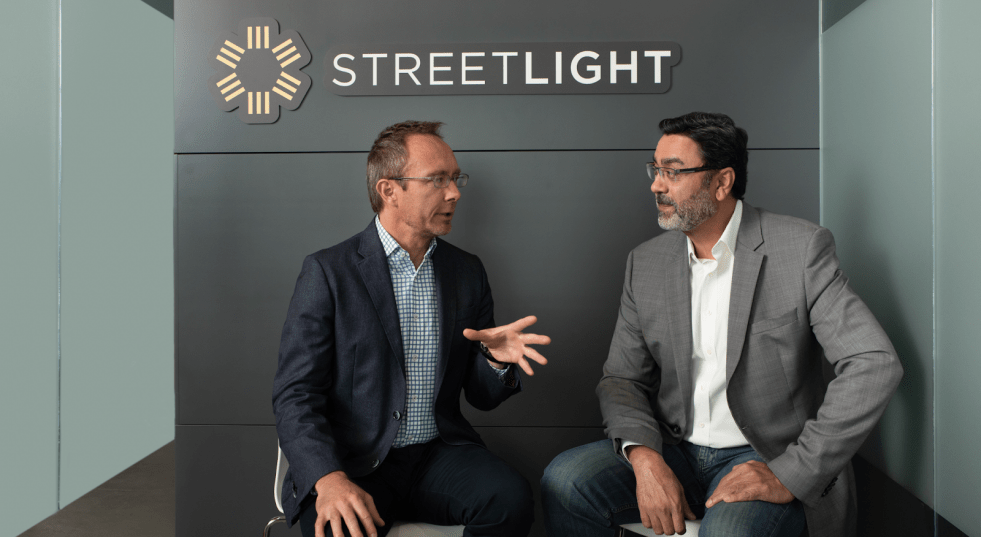
We sat down with Martin and Sal to talk IoT and Big Data at StreetLight’s San Francisco headquarters.
What is the biggest mobility challenge that municipalities are struggling with?
Martin: Mobility is connected to so many important quality of life topics: congestion, public safety, climate change/VMT greenhouse gasses, social equity — they’re all affected by transportation.
What we see in the industry is that agencies and public sector firms are trying to make sense of the high-tech direction in which mobility is heading. For example, how does a city partner with Transportation Network Companies (TNCs), like Lyft and Uber? How can cities deploy the Internet of Things (IoT) to support infrastructure? How can they use data to improve transit for under-served segments of the community?
Sal: I work with cities that have invested heavily in cutting-edge infrastructure, like IoT sensors, but they’re having trouble justifying that expense with subsequent impact. Planners and other transportation experts are using data to look closely at all the interrelated issues that fall under mobility, but they are struggling to get a holistic view of all of the factors, in a way that’s linked and responsive.
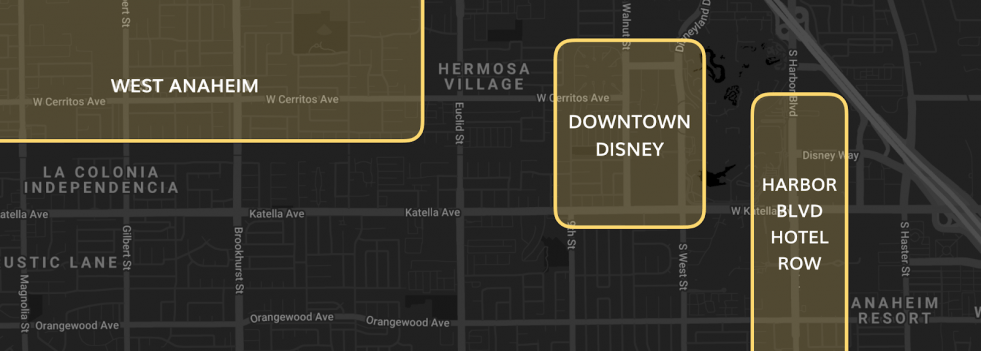
Integrated Big Data can create analytics for entire zone sets, not just for individual roads that have physical sensors installed. In this example, an analysis covers pedestrian, bicycle, and vehicle movements throughout three large zones near Disneyland.
Why aren’t these high-tech IoT sensors they giving us the holistic view of mobility that we need?
Sal: Sensors are an effective way to gather analytics, but people are still collecting data in very siloed ways. For example: bike/pedestrian sensors, vehicle data, and safety sensor data are each stored different databases.
It can get expensive quickly, paying for multiple data streams, and those disparate sources are hard to bridge. The cities that are moving forward most effectively are finding ways to relate various data flows to each other. That creates efficiencies in costs and in workstreams.
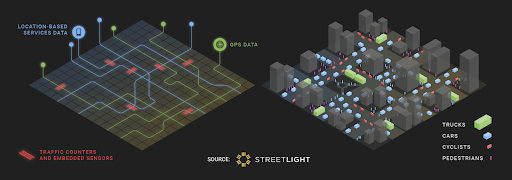
Combining physical IoT sensors with billions of “virtual” LBS and GPS-based location records enables a comprehensive dashboard of activity on roads, bike lanes and sidewalks in cities across North America.
So, this shift is less about the actual technology and more about managing technology?
Martin: It is. Shifting to a high-tech mobility future is challenging transportation experts to think in a different way. It used to be the car was the common thread for all this data, but we are now making room for so many new modes, and new ways to gather analytics for those modes.
We’re at the point where we have plenty of data, now it’s time to start understanding these issues and how they interact. Mobility experts have created measurement tools, but not as much thought about how they all come together for the bigger picture.
Big Data is helping integrate these data flows, making sense of disparate sensors and creating a single-source “dashboard” that gives cities a whole new level of insight into the modes on their streets.

StreetLight’s RouteScience® machine learning engine, trained and validated using 1,000s of physical sensors, enables transportation analytics with a high level of accuracy. AADT is a StreetLight metric available for virtually any road in North America that enables departments of transportation to supplement or replace manual traffic counts.
Can you give us an example of this holistic data approach in practice?
Sal: Sure, we recently worked with the Bay Area Air Quality Management District in San Francisco. They used our transportation analytics platform to run some studies for the Port of Oakland.
The City of Oakland was very concerned about public health and safety, with trucks coming out of the port and driving through town. In this case, “public safety” encompasses private and commercial vehicle collisions, bike and pedestrian travel, air quality, and potentially even social equity issues for truck routing through residential areas. You need a holistic view to study the issue thoroughly.
Oakland’s planners were able to use trip analytics from a single platform to study all of these issues, even using the analytics to create air quality models.
The segment analysis revealed which streets are supporting the most trips, and along which routes. We could separate commercial traffic to see that port trucks from Oakland are responsible for 18% of all vehicle miles traveled (VMT), which contributes the most to greenhouse gas. Then we explored the safety layer by going through city streets and looking at potential pedestrian and bicycle conflicts by analyzing those trips.
Finally, for a city like Oakland that has a history of social equity issues, the analytics include demographic data that helps planners understand the impact traffic has on historically under-served and under-reported areas and residents.
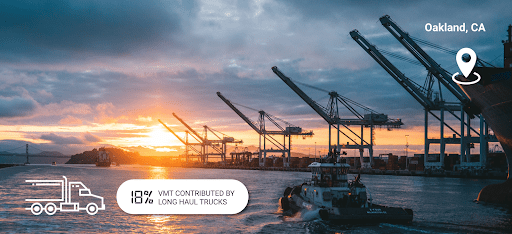
Transportation metrics for the Port of Oakland figured heavily into a comprehensive transportation study commissioned by the city.
What’s ahead for cities that are already at this level of holistic analytics?
Martin: I think what you’re going to see is that municipalities with access to holistic analytics will start to get really powerful insights about mobility that they didn’t even know were possible. Better managing the data can free up resources. Access to more resources allows people to go deeper and do more.
In fact, we expect this type of holistic thinking to expand beyond transportation, connecting mobility to the entire fabric of a community. Commuting, air quality, safety, energy use, and social equity are all quality of life issues that mobility touches. So, better mobility analytics can ultimately mean better quality of life for everyone.
Discussion
Leave your comment below, or reply to others.
Please note that this comment section is for thoughtful, on-topic discussions. Admin approval is required for all comments. Your comment may be edited if it contains grammatical errors. Low effort, self-promotional, or impolite comments will be deleted.
Read more from MeetingoftheMinds.org
Spotlighting innovations in urban sustainability and connected technology
Middle-Mile Networks: The Middleman of Internet Connectivity
The development of public, open-access middle mile infrastructure can expand internet networks closer to unserved and underserved communities while offering equal opportunity for ISPs to link cost effectively to last mile infrastructure. This strategy would connect more Americans to high-speed internet while also driving down prices by increasing competition among local ISPs.
In addition to potentially helping narrow the digital divide, middle mile infrastructure would also provide backup options for networks if one connection pathway fails, and it would help support regional economic development by connecting businesses.
Wildfire Risk Reduction: Connecting the Dots
One of the most visceral manifestations of the combined problems of urbanization and climate change are the enormous wildfires that engulf areas of the American West. Fire behavior itself is now changing. Over 120 years of well-intentioned fire suppression have created huge reserves of fuel which, when combined with warmer temperatures and drought-dried landscapes, create unstoppable fires that spread with extreme speed, jump fire-breaks, level entire towns, take lives and destroy hundreds of thousands of acres, even in landscapes that are conditioned to employ fire as part of their reproductive cycle.
ARISE-US recently held a very successful symposium, “Wildfire Risk Reduction – Connecting the Dots” for wildfire stakeholders – insurers, US Forest Service, engineers, fire awareness NGOs and others – to discuss the issues and their possible solutions. This article sets out some of the major points to emerge.
Innovating Our Way Out of Crisis
Whether deep freezes in Texas, wildfires in California, hurricanes along the Gulf Coast, or any other calamity, our innovations today will build the reliable, resilient, equitable, and prosperous grid tomorrow. Innovation, in short, combines the dream of what’s possible with the pragmatism of what’s practical. That’s the big-idea, hard-reality approach that helped transform Texas into the world’s energy powerhouse — from oil and gas to zero-emissions wind, sun, and, soon, geothermal.
It’s time to make the production and consumption of energy faster, smarter, cleaner, more resilient, and more efficient. Business leaders, political leaders, the energy sector, and savvy citizens have the power to put investment and practices in place that support a robust energy innovation ecosystem. So, saddle up.

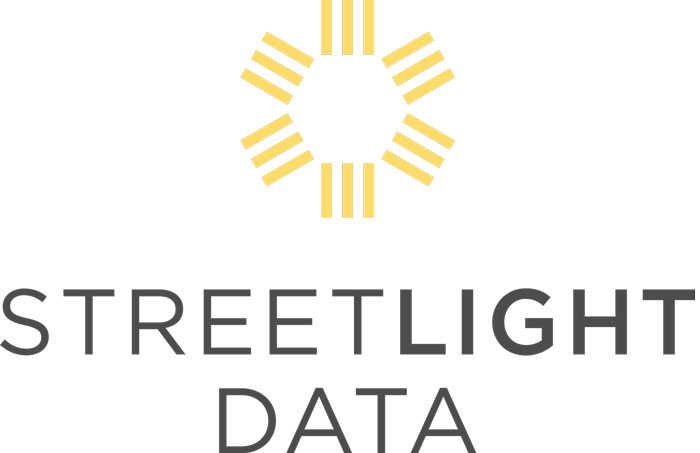





0 Comments